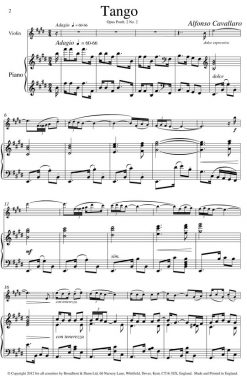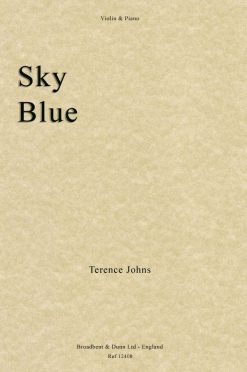£9.95
This 2014 publication might well have been composed 300 years earlier, being a truly baroque sonata in four movements (slow-fast-slow-fast). The composer has adhered not only to the harmonic and structural idioms of the time, but also to many of the other “unwritten” conventions. The work invites a great deal of freedom, and even leaves room for some improvisation. In the third movement the violin enters on a long, held note – this pattern recurs throughout, and in some ways appears to echo similar long notes in Bach’s B Minor Sonata. The last movement is a set of variations, though neither chaconne nor passacaglia – these are melodic, in the Italian manner, and clearly sound less baroque. The thematic material derives from the opening of Papageno’s aria Ein Mädchen oder Weibchen from Mozart’s Magic Flute, but transposed from F Major to D Minor. This sonata was premiered at the Lincoln Center by Bobby Portney and has subsequently been recorded by Sarah Darling and can be heard on YouTube:
https://www.youtube.com/watch?v=UigLnCPNYSw
Piece Description
This 2014 publication might well have been composed 300 years earlier, being a truly baroque sonata in four movements (slow-fast-slow-fast). The composer has adhered not only to the harmonic and structural idioms of the time, but also to many of the other “unwritten” conventions. The work invites a great deal of freedom, and even leaves room for some improvisation. In the third movement the violin enters on a long, held note – this pattern recurs throughout, and in some ways appears to echo similar long notes in Bach’s B Minor Sonata. The last movement is a set of variations, though neither chaconne nor passacaglia – these are melodic, in the Italian manner, and clearly sound less baroque. The thematic material derives from the opening of Papageno’s aria Ein Mädchen oder Weibchen from Mozart’s Magic Flute, but transposed from F Major to D Minor. This sonata was premiered at the Lincoln Center by Bobby Portney and has subsequently been recorded by Sarah Darling and can be heard on YouTube:
https://www.youtube.com/watch?v=UigLnCPNYSw
Review: “This is an absolutely outstanding composition. A truly baroque sonata written by a contemporary …. what a relief and pleasure it is to hear some ‘real’ music composed by a modern-day composer. It’s a wonderful and sincere Sonata that deserves great exposure and attention from music lovers around the world.” – Alexander Makov (Paganini Competition prize winner), New York, January 2014
Review: “It was truly an honor to present the world premier of this ‘new’ baroque sonata at Lincoln Center. It felt almost as though we were debuting the newly-found work of an 18th century composer.” – Dr. Robert Portney, January 2014
Review: “While the Raindrops Fantasia is Baroque in style, with virtuoso salon music inflections, the first three movements of the Sonata are purer homage to Corelli and the like, with the fourth movement titled, Variations in the Italian manner on a theme by Mozart. Cavallaro intends performers to add their own bowings, ornamentation and dynamics and perhaps by doing so add some contemporary authenticity. Again, it is worth listening to the recording of him and violinist Sarah Darling this time on YouTube. It may be true that violin students are spoilt for choice once they reach a certain level but both these works could well engage someone of Grade 7-8 standard – perhaps an adult student who is looking for something different.” – Helena Ruinard in the Music Teacher magazine, April 2019
Additional information
| Media | |
|---|---|
| Composer | |
| Instrumentation | |
| Difficulty | |
| Series |
Biography
Biography
Cavallaro, Lenny
Lenny Cavallaro (born 1947) notes with some wry amusement that the top four names on Anthony Tommasini’s list of 'Top 10 Composers were Bach, Beethoven, Mozart, and Schubert. These men, he asserts, are his gods, and the geniuses whose works he seeks to emulate. The result, not surprisingly, is that most of Cavallaro’s music sounds as though it was written between 1720 and 1830. Lenny has been called "the reactionary neoclassicist", and one critic went so far as to call him "a throwback to Schubert".
Cavallaro has written two sonatas in the baroque style (for violin and piano or harpsichord, and oboe and clavier), a keyboard partita, an organ fugue, and some contrapuntal chamber music. He has written two piano sonatas in the classical style, Songs Without Words loosely modeled after Mendelssohn, and a number of more Romantic works closer to Schubert in spirit.
Cavallaro, an accomplished pianist, was a top prizewinner in the J.S. Bach International Competition for Pianists and subsequently played that composer's Six Partitas to the highest critical acclaim in Carnegie Recital Hall. He earned a Doctor of Musical Arts degree from West Virginia University. Additionally a man of letters, he served for nine years as music critic for the New Haven Register and is author or co-author of six books. He edited and revised Paganini's Fire, a novel based on the life of that legendary violinist by Ann Abelson, released in November 2011 by Stay Thirsty Press. He teaches English at Northern Essex Community College. Finally, Cavallaro is also a therapist practicing hypnosis, hyperempiria, and other healing arts. See http://www.lennycavallaromusic.com

Related products
Violin & Piano
Violin & Piano
Lenny Cavallaro – Sonata No. 1 in D Minor for Violin and Piano (or Harpsichord) Opus 4
Violin & Piano
Violin & Piano
Alfonso Cavallaro – Serenade for Violin and Piano Opus Posth. 2 No 1 – Digital Download
 Terence Johns - Sky Blue (Violin & Piano) - Digital Download
Terence Johns - Sky Blue (Violin & Piano) - Digital Download  Alfonso Cavallaro - Tango for Violin and Piano Opus Posth. 2 No 2 - Digital Download
Alfonso Cavallaro - Tango for Violin and Piano Opus Posth. 2 No 2 - Digital Download 







